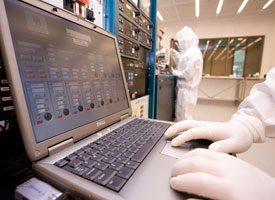Researchers from Greater Houston area welcome
Even the tiniest speck of dust can be a nuisance when you are working with nano-sized objects.
That’s because these objects are so small, tens of thousands of times smaller than the diameter of a human hair, even the tiniest dust particle can seem enormous.
A new research facility, packed with state-of-the-art equipment, has been created at the University of Houston to enable scientists to manipulate materials at the nanoscale in an environment virtually free from dust and other contaminants that can interfere with their results.
Dubbed the University of Houston Nanofabrication Facility, the laboratory is located on the first floor of the Science and Engineering Research Center and is now open for business.
“These nano-objects are so small and often packed so close to each other, one dust particle can ruin things on this scale,” said Dmitri Litvinov, a UH Cullen College of Engineering professor and director of the facility. “Assembling a comprehensive nanofabrication toolset in one location, and keeping these contaminants out, allows us to expand nanotechnology research at UH and elsewhere and make devices that impact peoples’ quality of life.”
Expansive Offerings
At more than 3,800 square feet, the facility is one of the largest on campus. It’s much cleaner too. Access requires entering a special gowning room and slipping on a protective white suit.
Once outfitted, researchers can use the kind of cutting-edge tools necessary to do everything from device prototyping to characterization of nano-scale materials in air meticulously monitored to ensure it keeps its class 100 rating. This means no more than 100 particles—.5 microns or larger—are in a cubic foot of air.
Even cleaner is the lithography room with a class 10 rating. It must be, insists Litvinov, who holds funding for several nano-scale projects himself.
“The lithography room is where nanometer sized structures are initially defined,” he said. “Any defects introduced at this stage would propagate and get amplified throughout the rest of the fabrication cycle and ruin results.”
It’s why Jiming Bao, assistant professor of electrical and computer engineering, has been working in the space recently—taking advantage of the facility’s electron beam lithography, focused ion beam and soft lithography foundry machines. Without this equipment and this highly controlled space, Bao admits it would be difficult to further research that works to help doctors better deal with spinal cord injuries.
Like Bao and Litvinov, researchers from across disciplines in engineering, physics and other areas of the university are benefiting from the facility’s recent opening. It’s easy to understand why.
Beyond the lithography room, in the middle of the space, is the materials synthesis and dry etching room while a third room holds the solvent and acid exhausted wet benches. All three offer an extensive tool list, which includes a mask aligner, ellipsometer, ion milling system, quality control scanning probe microscope, wet etch stations and several reactive ion beam etching and sputter deposition systems.
They are machines many researchers, such as Gila Stein, would have difficulty gaining access to if it were not for the space.
An assistant professor of chemical and biomolecular engineering, Stein’s research has applications for microelectronics fabrication. She uses the space extensively, preparing materials in her own lab, then making her way across campus to the clean room to use the patterning equipment.
“If the clean room weren’t here I would be doing a lot of traveling,” said Stein. “I would be flying to national labs, staying a couple weeks at a time and then flying back. Having this centralized space offers me time and cost-saving benefits.”
Extending Reach
The facility was developed in cooperation with the Alliance for Nanohealth, a coalition of eight institutions that include UH. It aims to use nanotechnology to bridge the gap between biology, medicine, computer technology, materials science and public policy.
According to Mauro Ferrari, the president of the alliance and a professor and chairman in the University of Texas Department of Nanomedicine and Biomedical Engineering, the facility is a critical need.
“The Alliance for Nanohealth has strongly endorsed the UH Nanofabrication Facility as a paradigm for a shared, core resource,” said Ferrari. “The facility fills a major gap in Houston, and will allow medical technology researchers to attain otherwise unthinkable achievements in the screening, diagnosis and therapy of diseases.”
The alliance, together with the Cullen College, helped bring the majority of the equipment to the facility.
The hope now that it’s officially open is to extend its use to researchers outside the university. Litvinov, and others in the college who manage it, are working to make this possible. Lockers have been installed and four rooms are equipped with computers and desks for these outside users who are welcome with proper training and payment of a user fee.
“All researchers from the University of Houston and the Greater Houston area are strongly encouraged to explore the possibilities the facility offers,” Litvinov said. “This facility represents a significant investment into the research toolset that supports a wide range of materials and device programs including scalability of magnetic devices, nanolithography, biosensors, drug delivery systems as well as resistive RAM, fuel cells, high temperature superconductors, nanoscale light sources, nanomechanics, data storage and nanostructured spintronic devices. The more users the facility attracts, the more efficient and streamlined the overall operation will be.”
